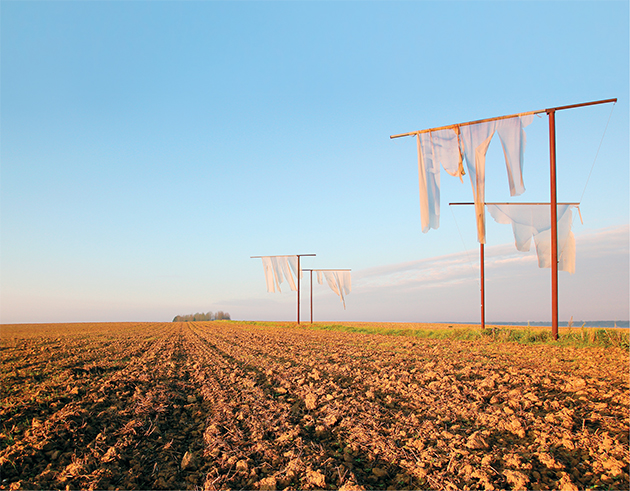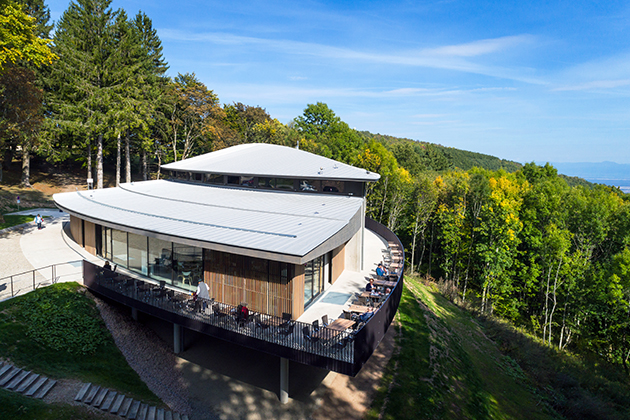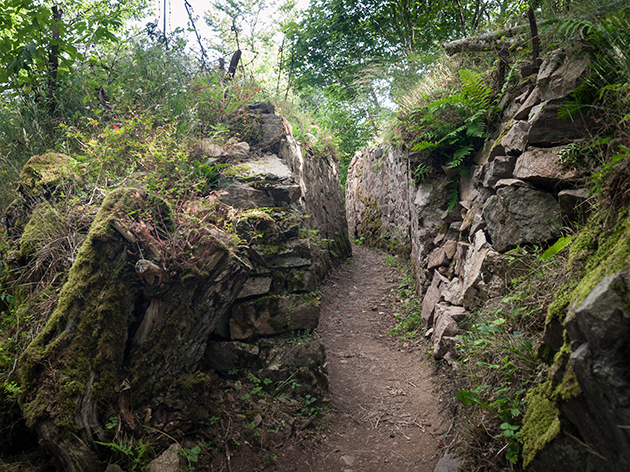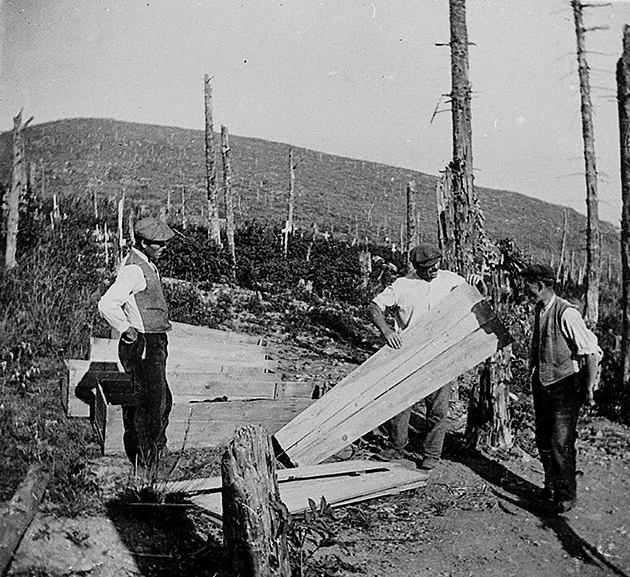Landscapes as remembrance sites

The relationship between war landscapes and remembrance is complex. After the conflict, what remains of the ‘war landscape’? How do societies construct a special approach to places scarred by war? In what ways do contemporary values attributed to the landscape transform society’s relationship with remembrance?
“The first time I ever really thought about battlefields was when I went to Dunkirk with my father. He had fought there in 1940. I was fascinated by his memory of the place, by the way he looked at it.” This quote, taken from an interview with British photographer Michael St Maur Sheil on the Verdun battlefield, for a 2017 Arte documentary entitled Verdun, paysage après la guerre (Verdun, a postwar landscape), sums up the complexity of the relationship between memory and landscape, and the construction of landscapes as ‘remembrance sites’, individually and collectively. It restores the multiple ways of looking at a place, tied to radically different experiences that can only lead to a divergence of viewpoints. But contemplating the beaches also functioned as a space-time for passing on the paternal memory, and came as a revelation to the photographer, forever changing his view of places marked by war. It was a revelation which he has for years attempted to convey through his photographs of battlefield landscapes, seeking to put himself as close as possible to the combatant’s experience, to extract a ‘truth’ through its ‘true’ representation: “When we look at the First World War battlefields, he says, filmed in the verdant landscape of Verdun, “we see them from the wrong point of view, because we are always standing. The men didn’t stand in the war: they were sprawled on the ground; they lived in the trenches. So, from as early on as possible, I tried to take my photos on the ground, to recreate the point of view of the soldiers of the time.” The perception and representation of the beach of Dunkirk or the woods of Verdun as traces of war requires the observer to “replay images that predate them” (Réra, 2017), in this case those produced by the paternal account or the First World War archives.
LANDSCAPE ARCHETYPES
Since most people, like the young St Maur Sheil, did not fight in the battle, what memories can tourists today mobilise when contemplating the beach at Dunkirk? How to decipher the horror of the fighting, of which no trace remains, or whose traces do not ‘speak’ for themselves? The contemporary tourist experience of the beach of Dunkirk as a remembrance site can be fed into by other images, as the local tourist office’s description of the coast suggests: “The spirit of the coast is a hotel a stone’s throw from the beach, [...] a stroll along the water’s edge and a passage from the Second World War history books. In terms of remembrance, the reading of the novel by a war correspondent telling the story of Operation Dynamo along its jetty and over its dunes. Also by way of remembrance, the making of the film Dunkirk by American director Christopher Nolan.” Historical accounts, novels and films all contribute in this way to constructing an imaginative landscape, associated with a military operation in which thousands of soldiers were massacred. By relentlessly immersing the viewer in the heart of the violence of men and the elements - water, sand, wind, fire, waves - Nolan’s film attempts to recreate the feelings and emotions of the British troops. It contributes to the construction of a mythical landscape that illustrates the ‘Dunkirk spirit’, described by Mark Connelly as the reactivated expression of a “long-standing national [British] saga” founded on a “sense of apartness, of otherness, of self-reliance and insularity, of coolness under tremendous pressure, of surviving against the odds.” (Connelly, 2014)
Yet, since 2014, there has been a reappropriation of the ‘Dunkirk spirit’ by the local council, interpreting it as the ‘spirit of resilience’ of the town and its inhabitants, highly representative of contemporary discourses affirming regional urban identities. The promotion of an image of Dunkirk as a ‘remembrance town’, preferred locally over ‘martyr town’, is part of a process of institutionalisation of representations of the past, which finds its expression in actions on the landscape: beyond the ‘rediscovery’ of the traces of the disaster - visits of shipwrecks from 1940 at low tide, reclassifying the everyday urban landscape through the promotion of reconstruction heritage - a range of actors have redeveloped public spaces to incorporate markers that make tangible the memory of a long-concealed past. Flags flying over the renovated esplanade of the museum extended in 2017, green spaces, contemporary sculptures, exposed military hardware: these elements combine to form a new urban backdrop, brought to life by the commemorative ceremonies, the circulation of tourists and the regular comings and goings of tour coaches. This landscape, whose ambiance is not unlike that of certain parts of Ypres or Arromanches, evokes the landscape archetype of an urban ‘remembrance site’. Thus, we are seeing the production of global landscape models (the ‘globalisation’ of remembrance, with widespread circulation of people, development models, knowledge and images), structured around common benchmarks, with local variations according to context and the representations constructed by a society, in the territory it inhabits, through how it relates to its environment and the organisation of its social relations.
PORTRAYING, IMAGINING... HALLUCINATING?
These few considerations on the beach of Dunkirk sum up the complexity of the concept of landscape: the coastal landscape emerges as a “multidimensional object whose dimensions - material, abstract and praxeological - are constantly interacting”; it is at once “a material object” (expanse of sand), “an object of representations” (both a symbol of British national pride and an element of local heritage), and “an object of action” (heritage and monument designation) (Gauché, 2015). As evidenced in St Maur Sheil’s account, it is defined by the existence of a sensory, aesthetic and affective relationship with a place, and also as a multisensory experience unique to each individual. Ultimately, it evokes the “multiplicity and complexity of meanings which individuals and societies mobilise to interpret the real in its totality, according to specific cultural references and schemes” (Derioz, 2012, cited by Gauché, 2015).
The landscape occupies a central place in the individual and collective memory of war. The devastation of the landscape by fighting or bombing has been endlessly depicted in the wake of conflicts. Those images, not of the moment of combat (war landscapes), but a retrospect that sometimes extends to the present (as Michael St Maur Sheil’s photographs show), are produced by actors from all spheres of society (artists, soldiers, journalists, writers, residents, tour guides, etc.). Descriptions, drawings, paintings, engravings, caricatures and, of course, photographs and film footage compose landscapes of traces as much as of absence. Images of a ‘flattened landscape’, of levelled forests, fields reduced to a muddy, shapeless mass, towns and villages in ruins, or beaches transformed into dumping grounds, stand as metaphors for a ravaged humanity (or an absence of humanity), the disappearance of ‘civilisation’ or the irretrievable loss of a ‘former world’. They are produced for wide-ranging purposes, depending on the context: artistic, political (propaganda, proof of the ‘barbarity’ or ‘savagery’ of the enemy), economic (challenges of reconstruction, tourism), documentary (archiving, etc.). They are put to a wide variety of uses: tucked away in archives or family albums, displayed, published, discussed, or else receiving such intense media attention that they raise some landscapes to iconic status (cathedral ruins, the Hiroshima Dome). They translate, in a range of registers, the terror, hatred, incredulity and despair of entire generations in the face of war, and they share the common goal of portraying a material environment as an ensemble of traces (of violence, fighting, destruction).

The Lost Men France, installation by Paul Emmanuel near the Thiepval Memorial, 2014.
Five photographs printed on silk banners (5 x 5 m each), steel poles 300 m apart.
© Paul Emmanuel. Courtesy of Art Source South Africa
Following the First World War, an imaginative landscape emerged which associated the fractures in the physical landscape with those suffered by bodies or communities; a landscape aesthetic of “disaster”, which “revived certain classical motifs of art history, starting with the ruin” (Réra, 2017; Danchin, 2015). It was closely bound up with the modernisation of techniques of representation (the role of photography) and the development of postwar social, cultural and political practices (commemoration, tourism, propaganda). That imaginative landscape persists to this day, though it underwent a profound transformation after the “unportrayable” Holocaust. Some contemporary photographers photograph the banality of a landscape that was formerly a theatre of violence, prioritising an “aesthetic of absence which serves to reveal the process of erasure of the traces” (Réra, 2015), while others act as ‘decoders’ or else produce ‘hallucinatory landscapes’ - in the sense used by Claude Lanzmann when filming Holocaust sites devoid of traces: “These disfigured sites are what I call ‘non-sites’ of remembrance. Yet at the same time, these traces must remain. I had to allow myself to hallucinate, and think that nothing had changed” (Lanzmann, 1990, cited by Réra, 2015).
LANDSCAPE AESTHETICS OF COMMEMORATION
Using the concept of ‘hallucination’ or a ‘hallucinatory relationship’ with place to describe an awareness of the landscape in which lost traces can/must reappear would seem an appropriate way to think about the landscape as a place of remembrance in contemporary societies. Are they not designated as the ‘last testimonies/witnesses’ of conflicts now ‘without witnesses’? The growing number of guidance tools (information boards, guides, orientation tables), ‘interpretation’ resources (interpretation centres, exhibitions, etc.) and techniques aimed at ‘making war present’ (ambient sounds, immersive experiences, re-enactments, virtual reality) convey well this stimulus to ‘find war’ in/through the landscapes of the present. The landscape as a place of remembrance thus presents a tension between erasing and revealing, absence and presence, invisibility and visibility.
Remembrance cultures, as social practices and representations of time, space and identities, model the landscape, both symbolically and materially, producing landscape archetypes. In the interwar years, landscape models emerged which were born of the tension between preservation and reconstruction/erasure of the traces, dominated by the expressions of combatants’ memory, national sentiment and mourning (Winter, 1998). Public actors, architects and landscape designers created them by safeguarding and developing the battlefields most symbolic to postwar societies. The construction of war memorials, monuments and cemeteries revealed a new landscape aesthetic of commemoration through the choice of forms, symbols (altars, crosses, etc.), materials, colours, locations, and also the reproduction of fragments of national landscapes (German woodland cemeteries, gardens planted with species from the native land). Certain landscape motifs became recurrent: the ruin (village, church, pillboxes, etc.), the trench (preserved or reconstructed), the central avenue leading the eye towards the memorial.

The Historial Franco-Allemand de la Grande Guerre, which opened on 10 November 2017, Hartmannswillerkopf. © AAA-IIIProd
In the 1980s, these landscape archetypes were enriched with new forms, changing the face of remembrance sites: contemporary artworks, museums and interpretation centres, usually in harmony with the earlier landscapes, are demonstrative of a process of cultural and tourism development of the landscapes and the reterritorialisation of remembrance policy. These cultural sites - often with restaurants, visitor centres and gift shops - introduce a secular dimension, stimulating debate and leading to the defence of specific architectural models, such as Gilles Marty’s design for the Historial Franco-Allemand in Hartsmannvillerkopf, which he describes as: “a humble approach that has the effect of fusing the new building with its natural and built environment [...] with the aim of creating an atmosphere of serenity and peace to echo the spirit of reconciliation” (Robischon, 2017). This kind of approach is already found in certain designs from the 1980s and 90s, such as the Péronne Historial museum (1992), dominated by ‘horizontality’, and the Vassieux Resistance Memorial (1994), ‘concealed’ in a Vercors rock face.
There are many other examples, of buildings that are austere, discreet, tucked away. Built in situ, they all favour panoramic views of the surrounding landscape, a crucial element in the social representation of ‘pacified landscapes’, whose ‘refound beauty’ symbolises peace and resilience. The ‘return of nature’ as a process more or less controlled by man - from remembrance gardens, to tree-planting on battlefields or leaving remains untouched - has become a central aspect in representations of landscapes as places of remembrance. In a context of heightened sensibility towards nature, nature is nevertheless the subject of two differing interpretations. It is either seen as a symbol of peace, or else its return is interpreted as the most tangible sign of forgetting (for instance, by Claude Lanzmann).

First World War trench in the Vosges forest. © M. Martinez Mateo
These representations echo a new scientific approach to the ‘natural’ or ‘environmental’ aspect of ‘polémo-paysages’. This term was coined in the 1970s and 80s in the academic world, specifically in northeastern France, to describe “war landscapes: devastated sites (fields, forests, ruined villages) that preserve important fossilised remains and traces of ‘environmental impacts’ (Arnould, 2017). Since the 1980s, these ‘war landscapes’ (terrestrial or marine, in the case of the landing beaches) have been the subject of increasingly precise observations and numerous studies in the academic world - in particular, archaeology and natural sciences.
They have also been exhumed by myriad associations whose many members are concerned with sites close to their day-to-day environment.
THE SOCIAL CONSTRUCTION OF APPROACHES TO THE LANDSCAPE
The process of widespread exhumation of ‘traces’ and the preservation of remnants of war raise the question of a ‘heritage’ approach to landscapes. Their official preservation as listed historic monuments (Hartmannswillerkopf in 1921, the ‘Red Zone’ of Vauquois in 1937) and sites (Verdun) reflects a progressive broadening of the concept of heritage - from the historic monument to the landscape - and of the levels of institutionalisation of the landscape. That broadening continues, as evidenced by the fact that the First World War cemeteries and memorial sites and the Normandy landing beaches are under consideration for UNESCO World Heritage labelling. This process reflects the renewed values associated with the landscapes, adjusted in line with UNESCO standards (“authenticity”, “universal value”, “outstanding value”), while also coinciding with certain contemporary paradigms of the ‘duty to remember’. The values proposed by the Normandy beaches as a place of remembrance - “freedom, peace, reconciliation” - reflect a very current dominant social representation of landscapes as places of remembrance, based on the rhetoric of peace, reconciliation and resilience. Though not entirely new in itself (cf. postwar pacifism), what is new is the way it has come to dominate in societies in the grip of uncertainty. It goes hand in hand with the social construction of the economic value of landscapes, in response to the imperatives of tourism development and the attractiveness of regions in the competitive context of globalisation.
National ‘monuments’ (the Australian Trail) or the expression of ‘shared’ (‘European’ or ‘world’) remembrance, the landscapes of conflict zones retain a key political function and, for many actors, a sacred value. Thus, besides the rhetoric of peace, the references brought into play in the representation, management and development of these landscapes have become diversified and hybridised. A wide variety of actors are involved in the planning process: from public actors (the National Forestry Office (ONF), which maintains the historic forests of Verdun; the Conservatoire du Littoral, which owns the landing beaches; the Parc Naturel Régional du Vercors, which manages the Site National Historique de la Résistance, to cite but a few), to residents, for whom the landscapes are also their day-to-day living environment, tourists who ‘consume’ them, entrepreneurs who ‘promote’ them, and so on.

Exhumation of graves at Hartmanswillerkopf, 1922. © Collection T. Ehret
The concept of “empaysagement” (Debarbieux, ‘Actualité politique du paysage’, Revue de géographie alpine, no 4, 2007) - literally, ‘enlandscapement’ - of memories can clearly be thought of as an important aspect of what some describe as contemporary ‘hypermnesia’. It refers to the landscaped design of places of remembrance, with an emphasis given to their ‘natural’, ‘wilderness’ side; to the now central role of the landscape as an interpreted image of reality, abundantly displayed in museums and interpretation centres as a vehicle for transmitting the past; and to the idea that memory is no longer linked to place as such, but to all aspects of the landscape.
In this regard, the design brief produced by landscape architecture agency Initial for the UNESCO application for the landing beaches reveals much about this new relationship with the landscape: “Through our project, we show how today the landscape alone is capable of transmitting this universal memory to future generations, like a monument of collective remembrance. It is our job to make that Landscape-Monument appear before the eyes of those who look at it, by researching its formal, physical and emotional qualities.” (Initial, 2015.) This presentation raises the issue of the political dimension of the landscape, especially in the unequal ability of the actors to represent or interpret it, still less to develop it, to express what should be kept of the past, and thus what is worthy of being seen.
The work by South African artist Paul Emmanuel interrogates this political dimension of the landscape. Located not far from the Thiepval memorial, the installation constitutes a break in the landscape. Through its form (the movement and lightness of the flowing silk contrasting with the fixity of the memorial), its ephemeral nature and vulnerability (the progressive deterioration of the work), and its meaning (the expression of a radical critique of forms of domination), the work creates a new landscape archetype, dissonant and critical: the landscape as a place of counter-remembrance.
Anne Hertzog - University of Cergy-Pontoise

